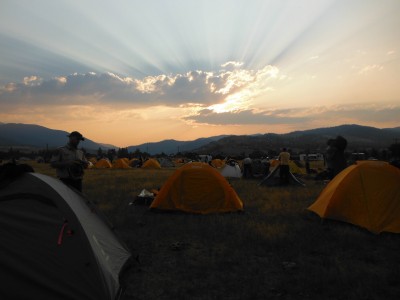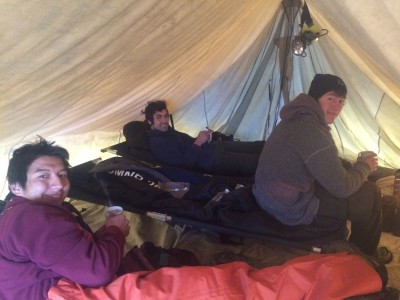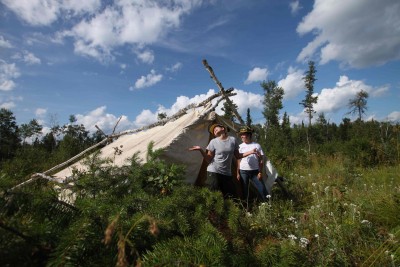 One of the most challenging fires I ever worked was in my first year: SLK047. It was in Wabakimi Provincial Park. We were going in to help lay line and protect a caribou-mating site in case the fire came that way. We sustained our line within the first two days, and spent the next six patrolling our line for smokes. It was the most mentally challenging fire I’ve been on yet. It was hot. Extremely hot. The mosquitoes were outrageous. The horse flies were abundant. The soot from the fire was drawn to the sweat on my skin. And there was no swimming hole to regain sanity. At the end of each day, I would crawl into my tent, lay on top of my sleeping bag in my gitch, sprawl all my limbs, and take 10 deep breaths; you can do this, you can get through this. Some days seemed so long. That personal time in my tent at the end of each night was clutch; time to reflect, recoup, and reassure.
One of the most challenging fires I ever worked was in my first year: SLK047. It was in Wabakimi Provincial Park. We were going in to help lay line and protect a caribou-mating site in case the fire came that way. We sustained our line within the first two days, and spent the next six patrolling our line for smokes. It was the most mentally challenging fire I’ve been on yet. It was hot. Extremely hot. The mosquitoes were outrageous. The horse flies were abundant. The soot from the fire was drawn to the sweat on my skin. And there was no swimming hole to regain sanity. At the end of each day, I would crawl into my tent, lay on top of my sleeping bag in my gitch, sprawl all my limbs, and take 10 deep breaths; you can do this, you can get through this. Some days seemed so long. That personal time in my tent at the end of each night was clutch; time to reflect, recoup, and reassure.
 Since that fire, I’ve always gravitated towards using my personal tent. Once crews have establish a camp, they have the option of ordering a big canvas tent that can sleep all four crew members: a prospector tent. Anytime that talk of using a prospector comes up, I always say “you guys can, but I’ll stick to my personal.” Until this year. KEN005. An April spring fire. Temperatures were hovering around 0oC at night, with predictions of snow on its way. So we ordered a prospector. And there we lay. Four adults. Sleeping, snoring, and sleep talking in the same tent. Snug as a bug in a rug. I actually enjoyed it. Despite the lack of privacy, I got to bond with my crew; story telling, and wisdom sharing. It was surprisingly nice to be housed with the boys for a few nights.
Since that fire, I’ve always gravitated towards using my personal tent. Once crews have establish a camp, they have the option of ordering a big canvas tent that can sleep all four crew members: a prospector tent. Anytime that talk of using a prospector comes up, I always say “you guys can, but I’ll stick to my personal.” Until this year. KEN005. An April spring fire. Temperatures were hovering around 0oC at night, with predictions of snow on its way. So we ordered a prospector. And there we lay. Four adults. Sleeping, snoring, and sleep talking in the same tent. Snug as a bug in a rug. I actually enjoyed it. Despite the lack of privacy, I got to bond with my crew; story telling, and wisdom sharing. It was surprisingly nice to be housed with the boys for a few nights.
Some of these luxuries we’ve learned to take for granted. I don’t think that any ranger initially thinks of a prospector as a luxury. But there’s that feeling that my tent is my safe place. That I have privacy and protection from the elements. That I can snuggle in and find warmth come morning. That I have defenses against the environment. That at the end of my time on the fire line, I get to go home, to my house, take a bath, and lay down in a comfy bed. That I have a place to call home.
 One of the most striking things about Kenora is the homeless population of First Nations people living on the downtown streets. Despite the time of year, homeless people hang around the No Frills, stumble into the library, and wander around the streets. The majority of these people are often battling their own personal challenges with substance abuse, mental illness, or physical impairment. Despite asking many people, I’m still unclear as to why the homeless population is so high. I’ve heard that within the past decade, more residents from nearby communities are coming into town. I’ve also heard that overcrowded housing on reserve land is a growing concern. Multiple generations living in small housing, with improper ventilation, and insufficient building materials is negatively impacting physical respiratory health, and potentially impacting overall mental health—where’s that safe, individual reflection time? Overcrowding is said to be a occurring because of insufficient housing, but sometimes I get the impression that intergenerational housing is a cultural norm. When I graduated high school, my mother didn’t seem to blink twice at giving me the boot out the door, telling me that I could come back if I NEEDED to live there, but we would have to discuss the terms and conditions. I don’t get the “sink or swim” vibe from the Ojibway culture. Shoomis will assume the role of main breadwinner if needed. Kookum will help the Namama take care of her new baby. No questions asked. So while overcrowding may be in part due to insufficient housing, I think there’s also a cultural aspect playing its part here.
One of the most striking things about Kenora is the homeless population of First Nations people living on the downtown streets. Despite the time of year, homeless people hang around the No Frills, stumble into the library, and wander around the streets. The majority of these people are often battling their own personal challenges with substance abuse, mental illness, or physical impairment. Despite asking many people, I’m still unclear as to why the homeless population is so high. I’ve heard that within the past decade, more residents from nearby communities are coming into town. I’ve also heard that overcrowded housing on reserve land is a growing concern. Multiple generations living in small housing, with improper ventilation, and insufficient building materials is negatively impacting physical respiratory health, and potentially impacting overall mental health—where’s that safe, individual reflection time? Overcrowding is said to be a occurring because of insufficient housing, but sometimes I get the impression that intergenerational housing is a cultural norm. When I graduated high school, my mother didn’t seem to blink twice at giving me the boot out the door, telling me that I could come back if I NEEDED to live there, but we would have to discuss the terms and conditions. I don’t get the “sink or swim” vibe from the Ojibway culture. Shoomis will assume the role of main breadwinner if needed. Kookum will help the Namama take care of her new baby. No questions asked. So while overcrowding may be in part due to insufficient housing, I think there’s also a cultural aspect playing its part here.
Irrespective of the exact reasons, the reality of an increasing population of homelessness in Kenora persists. While new eyes see this as a major problem, you can see why the same eyes on a growing problem are tired of coming up blank on the drawing board for attempting to implement solutions. While locals who drive around town and enjoy the comfort of their home will readily point their finger and roll their eyes at the people who are homeless, how can we expect soldiers fighting personal battles to integrate themselves into the complex and daunting procedures of homeownership, with little or no skill development on seeking employment or housing?
Every winter the city of Kenora strives to provide housing for all those who don’t have a house to stay in. But that’s just it—they’re providing a house. How can we start building an environment to hone the personal skills required to provide and sustain these populations with homes—a place where they can go at night, lay down on their bed, take 10 deep breaths and think “you can do this, you can get through this.”
Author Ariel Root is currently in Kenora in her fourth season working as a forest fire fighter for the Ontario Ministry of Natural Resources and Forestry. She has a BSc in Food Science & Nutrition from Carleton University in 2012, and is currently a graduate student in the Health Science, Technology and Policy program at Carleton University. She has been featured on APTN’s new hit TV show, Playing with Fire, Season 2.
Photos by Ariel Root
Follow us on twitter!